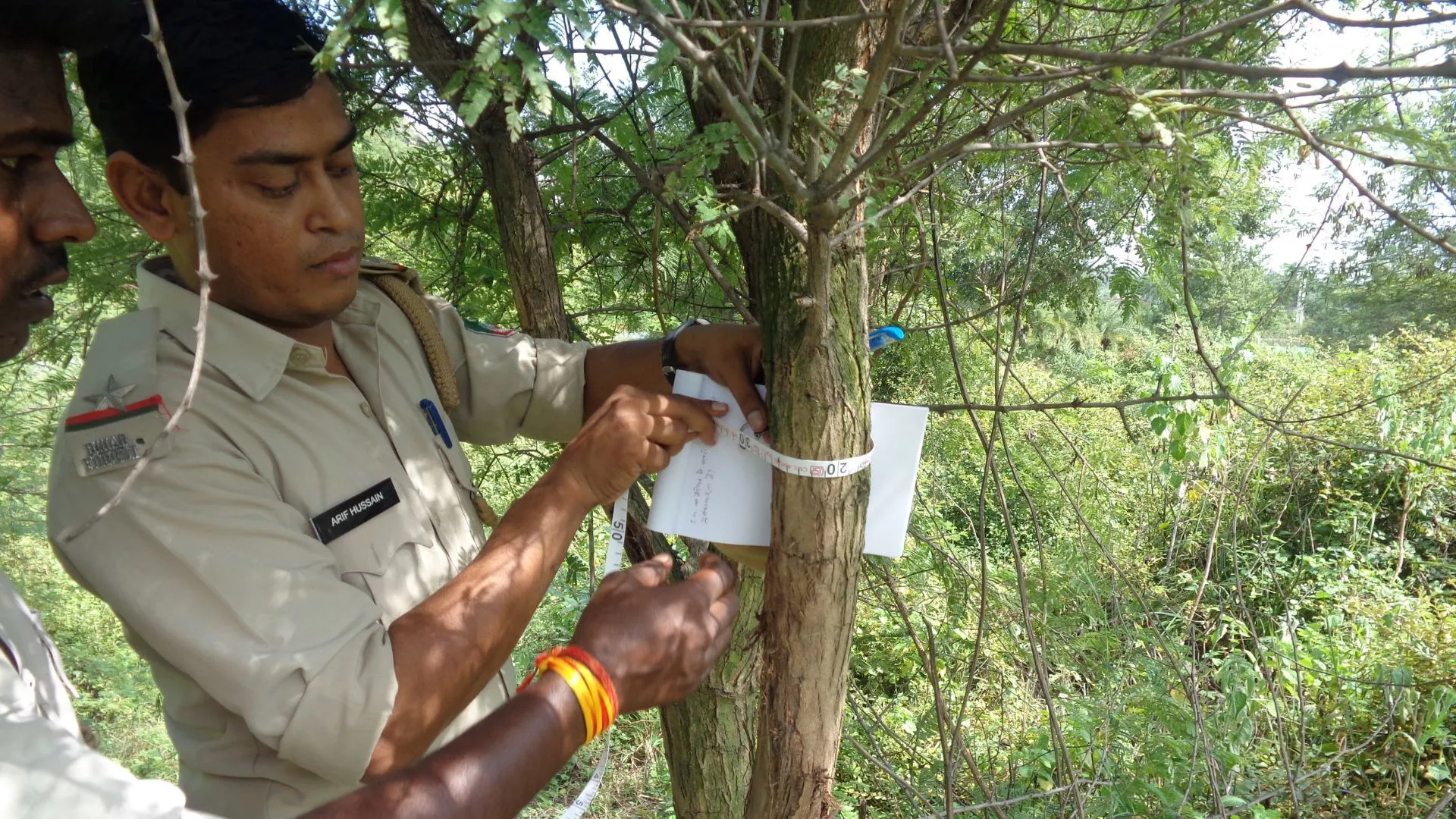Scaling up efficient forest management increases forest sustainability, economic opportunities and community livelihoods.
June 2022

Data collection for development of working plans using the Van system. (Photograph courtesy S. Sudhakar)
Forests and humans share a unique relationship. “In India, forests cover around 25 percent of the geographical area of the country and there are roughly around 300 million people who depend on forests directly or indirectly for their livelihood,” says Varghese Paul, forestry specialist and deputy director, General Development Office, at the U.S. Agency for International Development (USAID) in New Delhi. In addition, “forests provide habitat for endangered wildlife and critically important species like tigers and rhinos.”
People rely on forests for timber, medicinal plants and often bring their cattle to graze. “This degrades forests leading to negative impacts,” says Paul. If forests are managed better, they can pull more carbon out of the air, increase water yields, and improve livelihoods for indigenous and tribal communities.
“Forests are important from an ecological, climate change and socioeconomic and livelihood perspective in India,” says Paul. However, managing this resource “can be a labor-intensive task and must be done holistically, taking into consideration various aspects of the role forests play environmentally as well as culturally,” he explains.
Managing forests
To help improve the management of forests, USAID and India’s Ministry of Environment, Forest and Climate Change launched Forest-PLUS 2.0 as a five-year program in three forest divisions—Medak in Telangana, Gaya in Bihar and Thiruvananthapuram in Kerala. The program uses a variety of tools and livelihood interventions to enhance forest management and engage local communities.
One important tool is Van, an integrated system for collection of forest inventory and ecosystem data through a mobile app and automation of data analysis through a web portal. The Van system uses satellite images and geo-analytics to improve forest management and to collect data that is uploaded to a cloud-based data repository. The data analyzed informs forest management projects.
The efficiency and utility of the Van system has been established in Gaya, Medak and Thiruvananthapuram, where it has not only increased the accuracy of data collection but has also significantly decreased the time, and effort required for collecting and analyzing data. According to D. Tejasvini, beat forest officer, Medak Forest Division, the introduction of the Van system has not only helped increase her productivity, it has also reduced the time spent on data collection by almost 60 percent. The pre-listed customized information related to the Division has proved very helpful for Tejasvini while filling up the forms in the field.
In Gaya too, the Van system has provided valuable technical assistance to officials and ensured a stronger ecosystem-based management of forest landscapes. Van, along with a forest monitoring tool developed by Forest-PLUS 2.0, plays a vital role in protecting forest land from deterioration by providing reliable data via remote sensing instead of relying solely on field visits. “Right now, officers have been trained and we are updating our computer servers to store the data,” says S. Sudhakar, conservator of forest at the Gaya Forest Circle in Bihar.
“The Van system is being used to develop forest working plans covering 2 million hectares of forests in Kerala, Telangana and Bihar”, says Mark Tegenfeldt, director, General Development Office, USAID/India. He further explains that “the implementation of these plans will help reduce greenhouse gas emissions, increase carbon sequestration, improve water flows from forests and conserve biodiversity”.
Engaging local communities
Increasing economic opportunities for local communities is also an important aspect of the Forest-PLUS 2.0 program. “Ecotourism projects have been implemented in the Dungeshwari and Barabar hills,” says Sudhakar. Other livelihood interventions include moringa value chain products and the manufacture of incense sticks from recycled flowers from the Mahabodhi and Vishnupad temples. “Flowers are solid waste which is now being managed efficiently to make various products that are being sold by the joint forest management committees,” he says. Wild honey and pickles are manufactured as well. This will be upscaled and sold through outlets in Bodh Gaya where tourists will be major customers. “We are now in the pilot stage and plan to work toward commercialization,” says Sudhakar. “As we scale up, community employment opportunities will also increase.” However, future challenges may involve finding new platforms for the products. “Selling them on an online market may help increase demand and expand our customer base,” he says.
Developmental programs like these help forest officers work closely with village communities. This, in turn, helps create an understanding through which they can address issues like human-wildlife conflict more comprehensively, Sudhakar adds. The discussions and training facilitated by the Forest-PLUS 2.0 team helped them understand the program’s aims and objectives. “We work with a few forest committees who are currently very active and we plan on increasing outreach in the future,” says Sudhakar. “We regularly celebrate the Van Mahotsav forest festivals, meet with local committees, host film screenings on environmental issues and distribute information pamphlets on forest initiatives.”
Sudhakar’s aim as a forest officer is to get more such committees involved in a variety of activities. “We would like to replicate the Gaya model in the forest divisions of Rohtas and Kaimur,” he says. This way, Forest-PLUS 2.0 is able to target forested areas and scale up forest management efficiency with communities that depend on them most.
Paromita Pain is an assistant professor of Global Media Studies at the University of Nevada, Reno.
COMMENTS